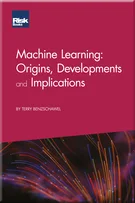Artificial neural networks
Miquel Noguer i Alonso, Daniel Bloch and David Pacheco Aznar
Artificial neural networks
7.1 PRESENTING RECURRENT NEURAL NETWORKS
7.1.1 An overview
Recurrent neural networks (RNNs) are an extension of feedforward neural networks (FNNs) in which we allow connections between hidden units associated with time delay (Elman 1990). Thus, RNNs can retain information about the past and can be used to discover temporal correlations between events that occurred deep in the past. While the connections between units in FNNs do not form a cycle, an RNN has a feedback connection, meaning the network nodes have cyclical connections. The existence of cycles allows RNNs to develop self-sustained temporal activation dynamics along their recurrent connection pathways, even without input, making them a dynamical system.
RNNs can be visualised by unfolding them along the whole input sequence. That is, in the case of time series, the RNNs are unfolded through time. The unfolded graph has no cycles (as in FNNs), so the forward and backward passes of a Multilayer Perceptron (MLP) can be applied. The MLP approximates non-linear functions. Since an RNN can be unfolded to a deep feedforward network, it has an advantage over MLP models, making the RNN a better approximator.
There are two main classes
Copyright Infopro Digital Limited. All rights reserved.
As outlined in our terms and conditions, https://www.infopro-digital.com/terms-and-conditions/subscriptions/ (point 2.4), printing is limited to a single copy.
If you would like to purchase additional rights please email info@risk.net
Copyright Infopro Digital Limited. All rights reserved.
You may share this content using our article tools. As outlined in our terms and conditions, https://www.infopro-digital.com/terms-and-conditions/subscriptions/ (clause 2.4), an Authorised User may only make one copy of the materials for their own personal use. You must also comply with the restrictions in clause 2.5.
If you would like to purchase additional rights please email info@risk.net











